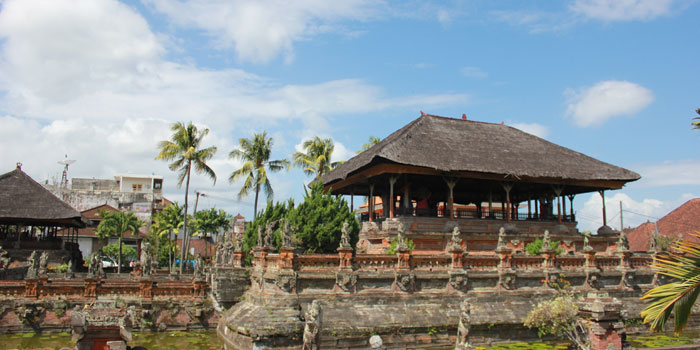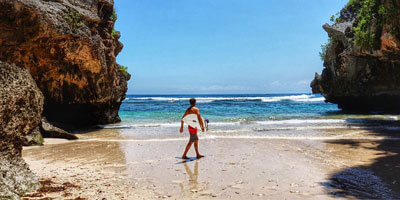History
Kertha Gosa means - “the place where the king meets with his ministries to discuss questions of justice.” The story of Bhima Swarga is elaborate and all-embracing. Bhima Swarga in Balinese means, “Bhima goes to the abode of the gods.” Swarga literally means to any place where the gods happen to reside, Heaven or Hell.
Bhima, the second oldest of the five Pandava brothers, is forced by his mother Kunti with the mission to rescue from Hell the souls of his earthly father Pandu, and his second mother, Madri. After saving Pandu and Madri from Hell, Bhima must secure them for Heaven. Throughout Bhima’s journey to Heaven and Hell he is accompanied by his two loyal servants (the clown characters). These made up characters are highly important to the story Bhima Swarga because the ordinary Balinese can relate to the characters in the story Bhima Swarga because the characters represent ordinary Bali.
Bhima’s siblings go through hell right along with Bhima to rescue their parents. The siblings observe people being tortured for their sins. The siblings are Arjuna, Nakula, Sahadewa, Yudhishthira, and Bhima. The two clown characters whom accompany Bhima on his journey to Hell are Twalen and Mredah. Twalen wears a black checkered loin cloth and is the helper to Bhima. Twalen translates what is being said by Yudhishthira and Kunti. Mredah always wears red checkered loin cloths and he also helps Bhima along with cracking a joke to lighten the mood. Bhima goes to Hell to rescue his parents and when he arrives he finds his parents are in a huge hot water bath. Bhima tips the bath which his parents were boiling in and they are taken off to Heaven. The Demons did not like Bhima rescuing his parents and allowing them to go to Heaven. Bhima then has to fight off the Demons. Next, the Gods do not like this idea of Bhima taking his parents from Hell to Heaven. Bhima then gets into a fight with the Gods and Bhima dies in Heaven. The high God of all restores Bhima back to life and gives Bhima the drink of immortality. The last scene of Bhima Swarga shows justice, even with punishments of Hell.
Use of iconography
The ceiling of Kertha Gosa is painted in a traditional Balinese style that resembles wayang, “shadow figure”. Paintings in the wayang style are related closely to shadow theatre art, relating to the Mahabharata and Ramayana stories. Wayang style paintings have been faithfully preserved that it continues today to reflect Bali’s Hindu-Javanese heritage in its traditional iconography and content. Iconography was used a lot in Bali’s culture. Iconoclasm is used because the Balinese people wanted to represent living things through pictures and shadows; it was prohibited to represent any living entity.
Use of iconography
Until the early twentieth century, the wayang style was Bali’s only form of pictorial ways. The ubud style developed after the arrival of the Dutch. Ubud style tends to represent aspects and scenes of everyday life in Bali. In iconographic language, color performs an important function. Very light brown is used for flesh color of the gods. Kasar characters can be recognized by their brownish-red flesh.
All the characters in the story of Bhima Swarga painted in the pavilion Kertha Gosa have a symbolic meaning relating to color and whether the characters are kasar or halus. Kasar characters are rough and coarse, whereas halus characters are refined and flowing. For example, the demons in the painting Bhima Swarga would be described as kasar - rough, coarse, crude, and vulgar. A halus figure can be described as refined and recognized by delicate hands and fingers. Bhima, his siblings, and Kunti are all halus characters. The angle of the head and body attitude of the characters are also important. For example, human heads and bodies are always a straight on position, but kasar paintings are represented in between with eyes and nose at an angle.
Kasar characters also have big eyes, noses, and mouths. The hand positioning of the kasar characters is upward. Kasar characters can be monstrous looking, have skin troubles, and look masculine. Halus characters have small eyes, noses, and mouths with almost no facial hair. The head and face are pointed downward. The lips of a halus character are thin and show white uniformed teeth. In paintings, the right hand is usually active, and the left hand remains motionless. One of Bhima’s most important features assigned to only him is his right thumb, which ends in a very long curved nail as his weapon, this is a magical implication.
Social hierarchy
In the paintings, social standing can be portrayed by the hierarchical position of the characters, the size of their body, the side on which they are placed (left or right of the scene). In Bhima Swarga story the statue of Siwa, Heaven’s most prominent god, is larger and more inflicting than any other god. Also, Bhima overpowers all other humans in the story. Bhima’s servants Twalen and Mredah usually appear side by side, with Mredah, Twalen’s son, placed a little below his father. Age and social class also play a role in the placement of the five Pandawa brothers. Bhima, since his power is strictly physical, his body must be unhindered and ready for battle. Around Bhima’s body wrapped flowingly is a sarong of black and white checked material that in Bali is believed to have magic protective qualities. In Heaven, battle scenes are not bloody. Bhima as usual is in the center of the war panels, his body is much smaller than in hell. Bhima’s body size is proving the importance of the hierarchy, since Bhima’s importance diminishes when he is around the gods.
The Bhima Swarga painting in the Kertha Gosa Pavilion is a moral epic, depicting wisdom and perseverance and the ultimate virtue over vice. Today huge audiences listen to the epic just as it was hundreds of years ago. It is said, “He who with fervid devotion listens to a recitation of the Mahabharata attains to high success in consequence of the merit that becomes his through understanding even a very small portion thereof. All the sins of that man who recites or listens to this history with devotion are washed off.”[this quote needs a citation]
The paintings of the Bhima Swarga story (painted in the traditional wayang style) depicted on the Kertha Gosa pavilion ceiling have a mystery to them. The story of Bhima Swarga occupies five rows and reads clockwise starting at the far northeastern corner of the ceiling. The first two rows of the Bhima Swarga paintings represent Bhima’s appearances in Hell, and the top three rows, his journey to Heaven. At the center of the ceiling, there is a lotus surrounded by four doves, symbolizing good fortune, enlightenment, and ultimate salvation.
Use of iconography
A patron of the arts, Dewa Agung Gusti Sideman took greatness in supervising the design and construction of his palace in Klungkung - an example of Hindu-Balinese architecture. Kertha Gosa architecture took the shape of a mandala - a Buddhist-influenced domed mountain shape. Mandalas help people further their enlightenment; pure forces of good come from a mountain. Kertha Gosa’s first major function pertained to court of law and justice. The Kertha Gosa pavilion was the meeting place for the raja (Hindu prince) and Brahman judges (Kerthas) to discuss issues of law and human affairs.[citation needed] Whether or not the king instructed his court painters to decorate the ceiling at the time Kertha Gosa was built is impossible to know. Moreover, it is impossible to know whether or not the story of Bhima Swarga was the first painting in the pavilion. The earliest and only record of paintings at Kertha Gosa dates from the year 1842 and is written in a lontar book (a book that holds prayers, history of Bali, and epics).[citation needed] Also it is not documented whether the paintings were a permanent feature of the pavilion or if it was for a temporary reason of celebration. It is possible that the raja might have wanted the story of Bhima Swarga since it deals with moral and social questions and with justice in general. These paintings, furthermore, have been supervised by I Gde Modara, the most important painter at the court of Klungkung during this period.
Dewa Agung Gusta Sideman ruled until 1775; he was succeeded by his son, then by his grandson, and his line of descendants continued to reign until the beginning of the 20th century. In 1908, the Dutch attacked Klungkung, and fire broke out in the royal area.[citation needed] To this day it is said that the fire was started not by the Dutch but by the local people because they were confused with the condition of their society and were rebelling against the raja. Klungkung was the last Balinese kingdom to fall. In 1909 Kertha Gosa became the official court of Justice for the region of Klungkung.[citation needed] Klunkung had been a unique service to justice; utilizing Kertha Gosa as a court of law - the story of Bhima Swarga played a significant role in aiding justice. Those who had broken the law therefore had been tried. The accused knelt before the dreadful punishments (painting of the story Bhima Swarga) depicted on the ceiling. But if the accused looked higher above the horror of Hell and looked to the panels of Heaven he could find consolation.
References
Covarrubias, M. Bali. Wikipedia.com. November 2006.
Pucci, Idanna. Bhima Swarga: The Balinese Journey of the Soul. 1st pbk. ed. Boston: Little, Brown, 1992.
Kerta Gosa Map








